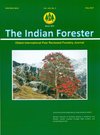Genetic Diversity of Bamboo Species in Andaman and Nicobar Islands Revealed through Dna Markers and Morphological Traits
DOI:
https://doi.org/10.36808/if/2017/v143i5/114954Keywords:
Bamboo, ISSR, RAPD, Morphological Traits, Genetic Diversity, Association.Abstract
Analysis started by using forty eight markers (Twenty four each of ISSR and RAPD) that allowed us to distinguish 10 bamboo species. Out of forty eight, twelve primers were used for identification and for establishing a profiling system to estimate genetic diversity. A total of six hundred and fourteen alleles were amplified out of this hundred and thirty seven distinct polymorphic DNA fragments, ranging from 1.15 - 0.20 kb were amplified by 12 selected primers. The morphological observations recorded at field level viz., average height of mature culms, average inter node distance and average diameter of the culm. It was observed that Bambusa bambos and Bambusa tulda were very similar to each other for all three characters. While Schizostachyum kalpongianum showed very different type of characters in all three traits. The genetic similarity analysis was conducted based on presence or absence of bands, which revealed a wide range of variability among the species. Combined cluster analysis revealed that the ISSR and RAPD markers studied were highly efficient in differentiating the bamboo species up to genera level. Upon endemic species studied, it is observed that two genus Gigantochloa and Schizostachyum were grouped to separate cluster whereas Dendrocalamus calostachys were grouped with Dendrocalamus strictus. Thus, the morphological characterization was confirmed by the genetic diversity analysis.References
Bahadur K.N. (1979). Taxonomy of bamboos. Ind. J. For., 2: 222– 241.
Bhattacharya S., Ghosh J.S., Das M. and Pal A. (2009). Morphological and molecular characterization of Thamnocalamus spathiflorus subsp. spathiflorus at population level. Plant Syst. Evol., 282: 13–20.
Chua K.S., Soong B.C., Tan H.T.W. (1996). The Bamboos of Singapore. IPGRI, Singapore.
Clayton W.D., Harman K.T., and Williamson H. (2013). Grass Basethe online world grass flora. Retrieved from: http://www.kew.org/data/grasses-db.html
Das M., Bhattacharya S. and Pal A. (2005). Generation and characterization of SCARs by cloning and sequencing of RAPD products: A strategy for species-specific marker development in bamboo. Ann. Bot., 95: 835–841.
Gami B., Bakhtiyar A.S. and Beena P. (2015). Assessment of genetic diversity in Bamboo accessions of India using molecular markers. Int . J. Appl. Sci. Biotechnol., 3(2): 330-336
Garbyal S.S., Naithani H.B. and Joju P. Allappatt (2008). Bamboo resources of Andaman and Nicobar Islands, India. Indian Forester, 134(7):1129-1135.
Kingdom K., Weston F.M., Kwapata M.B., Bokasi J.M. and Munyenyembe P. (2007). Genetic diversity of Annona selegalensis Pers population as revealed by SSRs. African J. Biotech., 6: 1239- 47.
Murray M.G. and Thomson W.F. (1980). Rapid isolation of high molecular weight DNA. Nucleic Acids Res., 8: 4321-25.
Muthusamy S., Kanagarajan S. and Ponnusamy S. (2008). Efficiency of RAPD and ISSR markers system in accessing genetic variation of rice bean (Vigna umbellata) landraces. Electronic J. Biotechnology, 11: 1-10.
Nayak S., Rout G.R. and Das P. (2003). Evaluation of the genetic variability in bamboo using RAPD markers. Plant Soil Environ., 49: 24-28.
Ohrnberger D. and Goerrings J. (1986). The bamboos of the world. Odenthal, Germany.
Rai S.N. and Chauhan K.V.S. (1998). Distribution and growing stock of bamboos in India. Indian Forester, 124(2): 89- 98.
Rohlf F.J. (1998). NTSYS-pc numerical taxonomy and multivariate analysis system version 2.02, Exeter Publications Setauket, New York.
Saini R.K., Saad K.R., Ravishankar G. A., Giridhar P. and Shetty N.P. (2013). Genetic diversity of commercially grown Moringa oleifera Lam. cultivars from India by RAPD, ISSR and cytochrome P450-based markers. Plant Systematics and Evolution, doi: 10.1007/s00606-0130789-7.
Shalini A., Meena R.K., Shubhankar T and Sanket T. (2013). Evaluation of genetic diversity in bamboo through DNA marker and study of association with morphological traits. Bull. Env. Pharmacol. Life Sci., 2 (8): 78-83
Sharma R.K., Gupta P., Sharma V., Sood A., Mohapatra T. and Ahuja P.S. (2008). Evaluation of rice and sugarcane SSR markers for phylogenetic and genetic diversity analyses in bamboo. Genome, 51: 91-103.
Sharma Y.M.L. (1987). Inventory and resource of bamboo. Recent research in bamboo In: Proceedings of the International Bamboo Workshop (Rao AN, Dhanarajan G, Sastry CB, eds.) China. Chinese Academy of Forestry, China and International Development Research Centre, Canada, 14–17.
Sneath P.H.A. and Sokal R.R. (1973). Numerical Taxonomy - The Principles and Practice of Numerical Classification. Freeman & Co. San Francisco.
Stapleton C.M.A. (1991). A Morphological Investigation of Some Himalayan Bamboos with an Enumeration of Taxa in Nepal and Bhutan. Ph.D. thesis, University of Aberdeen, Aberdeen.
Tewari D.N. (1992). A monograph of Bamboo. Dehradun, India: International Book Distributors, p. 495.
Downloads
Downloads
Published
How to Cite
Issue
Section
License
Unless otherwise stated, copyright or similar rights in all materials presented on the site, including graphical images, are owned by Indian Forester.





